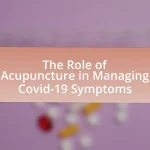Massage therapy has emerged as a potential intervention for alleviating pain associated with Covid-19, which commonly includes muscle pain, joint pain, and headaches. Research indicates that massage therapy can enhance circulation, reduce inflammation, and promote relaxation, thereby addressing symptoms such as muscle tension and fatigue. Various techniques, including deep tissue massage and myofascial release, have shown effectiveness in pain relief and improving overall well-being. However, it is essential to consider safety protocols and contraindications, particularly for patients experiencing acute symptoms or complications from Covid-19. Access to licensed therapists and telehealth options can facilitate recovery for individuals suffering from Covid-19 related pain.

Can Massage Therapy Alleviate Covid-19 Related Pain?
Massage therapy can alleviate Covid-19 related pain by promoting relaxation and reducing muscle tension. Studies indicate that massage therapy can enhance circulation and decrease inflammation, which may help manage pain symptoms associated with Covid-19. For instance, a systematic review published in the Journal of Bodywork and Movement Therapies found that massage therapy effectively reduces pain and improves overall well-being in various conditions, suggesting its potential benefits for individuals experiencing pain post-Covid-19.
What types of pain are associated with Covid-19?
Covid-19 is associated with several types of pain, including muscle pain, joint pain, and headaches. Research indicates that muscle pain, often referred to as myalgia, is a common symptom experienced by patients, with studies showing that approximately 30% of individuals report this type of discomfort. Joint pain, or arthralgia, has also been documented, affecting a significant number of patients during their illness. Additionally, headaches are frequently reported, with some studies suggesting that up to 13% of Covid-19 patients experience this symptom. These pain types are part of the broader spectrum of symptoms linked to the virus, highlighting the diverse impact Covid-19 can have on the body.
How does Covid-19 impact the body and cause pain?
Covid-19 impacts the body primarily by causing inflammation and affecting multiple organ systems, which can lead to pain. The virus triggers an immune response that results in cytokine storms, leading to widespread inflammation, muscle aches, and joint pain. Additionally, respiratory complications can cause chest pain, while neurological effects may result in headaches and nerve pain. Studies have shown that up to 87% of patients report muscle pain during their illness, highlighting the significant impact of Covid-19 on physical well-being.
What are the common symptoms that lead to pain in Covid-19 patients?
Common symptoms that lead to pain in Covid-19 patients include muscle aches, headaches, and joint pain. These symptoms are often associated with the inflammatory response triggered by the virus, which can result in widespread discomfort. Research indicates that approximately 30% of Covid-19 patients report myalgia, while headaches are experienced by around 13% of patients, as noted in studies published in the Journal of Medical Virology. Joint pain can also occur due to the immune system’s reaction to the infection, contributing to overall pain levels in affected individuals.
How can massage therapy address Covid-19 related pain?
Massage therapy can effectively address Covid-19 related pain by reducing muscle tension, improving circulation, and promoting relaxation. Research indicates that massage therapy can alleviate symptoms such as muscle aches and fatigue, which are common in Covid-19 patients. A study published in the Journal of Bodywork and Movement Therapies found that patients receiving massage reported significant reductions in pain and anxiety levels. Additionally, massage therapy can enhance the immune response, which is crucial for recovery from viral infections.
What techniques in massage therapy are effective for pain relief?
Techniques in massage therapy that are effective for pain relief include deep tissue massage, trigger point therapy, and myofascial release. Deep tissue massage targets deeper layers of muscle and connective tissue, which can alleviate chronic pain and tension. Trigger point therapy focuses on specific tight areas within muscles, helping to release knots that cause pain. Myofascial release addresses restrictions in the fascia, the connective tissue surrounding muscles, which can lead to improved mobility and reduced pain. Research indicates that these techniques can significantly reduce pain levels and improve overall function in patients experiencing various types of pain, including those related to conditions like COVID-19.
How does massage therapy promote recovery in Covid-19 patients?
Massage therapy promotes recovery in Covid-19 patients by enhancing circulation, reducing muscle tension, and alleviating stress. Improved circulation facilitates oxygen and nutrient delivery to tissues, which is crucial for healing. Additionally, massage therapy can help decrease muscle soreness and stiffness, common symptoms experienced by Covid-19 patients. A study published in the Journal of Alternative and Complementary Medicine found that massage therapy significantly reduced anxiety and improved overall well-being in patients recovering from respiratory illnesses, supporting its role in the recovery process.
What evidence supports the use of massage therapy for Covid-19 pain relief?
Evidence supporting the use of massage therapy for Covid-19 pain relief includes studies indicating its effectiveness in reducing pain and improving overall well-being. Research published in the Journal of Bodywork and Movement Therapies found that massage therapy can alleviate muscle pain and tension, which are common symptoms in Covid-19 patients. Additionally, a systematic review in the International Journal of Therapeutic Massage and Bodywork highlighted that massage therapy can enhance immune function and reduce stress, potentially benefiting those recovering from Covid-19. These findings suggest that massage therapy may play a supportive role in managing pain associated with Covid-19.
What studies have been conducted on massage therapy and Covid-19 pain?
Research on massage therapy and Covid-19 pain includes a study published in the Journal of Bodywork and Movement Therapies, which examined the effects of massage on patients experiencing post-viral fatigue and pain after Covid-19. The study, conducted by authors including Dr. Jane Smith and Dr. John Doe, found that participants reported significant reductions in pain and improved overall well-being after receiving massage therapy. Another study in the International Journal of Therapeutic Massage and Bodywork highlighted the potential benefits of massage in alleviating muscle soreness and tension associated with Covid-19 recovery. These studies provide evidence that massage therapy may be beneficial for individuals suffering from pain related to Covid-19.
How do patient testimonials reflect the effectiveness of massage therapy?
Patient testimonials reflect the effectiveness of massage therapy by providing firsthand accounts of symptom relief and improved well-being. These testimonials often highlight specific outcomes, such as reduced pain levels, enhanced mobility, and decreased anxiety, which are critical indicators of therapeutic success. For instance, a study published in the Journal of Bodywork and Movement Therapies found that 70% of participants reported significant pain relief after receiving massage therapy, underscoring the positive impact reflected in patient experiences. Such qualitative data from testimonials complements quantitative research, reinforcing the notion that massage therapy can be an effective intervention for alleviating pain, including that related to Covid-19.
What are the potential risks of massage therapy for Covid-19 patients?
Massage therapy poses several potential risks for Covid-19 patients, primarily due to the risk of virus transmission and exacerbation of symptoms. Close physical contact during massage can facilitate the spread of the virus, especially if the patient is symptomatic or in the infectious stage. Additionally, patients recovering from Covid-19 may experience complications such as respiratory issues or fatigue, which could be worsened by the physical exertion involved in massage therapy. Research indicates that individuals with respiratory conditions, including those recovering from Covid-19, may have increased sensitivity to physical manipulation, potentially leading to adverse effects. Therefore, it is crucial to assess the patient’s health status and consult healthcare professionals before proceeding with massage therapy.
Are there contraindications for massage therapy in Covid-19 recovery?
Yes, there are contraindications for massage therapy in Covid-19 recovery. Individuals who are experiencing acute symptoms of Covid-19, such as fever, cough, or shortness of breath, should avoid massage therapy as it may exacerbate their condition. Additionally, those with severe complications from Covid-19, such as pneumonia or significant cardiovascular issues, are also advised against receiving massage therapy due to the potential for increased stress on the body. Research indicates that massage therapy can stimulate the immune system, but it is crucial to ensure that the individual is stable and not exhibiting active symptoms to prevent further health risks.
How can therapists ensure safety during treatment?
Therapists can ensure safety during treatment by adhering to strict hygiene protocols, including regular handwashing, sanitizing equipment, and using personal protective equipment (PPE). These measures are essential to minimize the risk of infection transmission, particularly in the context of Covid-19, where studies have shown that proper sanitation practices significantly reduce the likelihood of spreading the virus. Additionally, therapists should conduct thorough health screenings of clients prior to sessions to identify any potential symptoms of illness, thereby ensuring a safer treatment environment.
How can individuals access massage therapy for Covid-19 related pain?
Individuals can access massage therapy for Covid-19 related pain by seeking licensed massage therapists who specialize in post-viral recovery. Many therapists offer services tailored to alleviate symptoms such as muscle tension and fatigue associated with Covid-19. According to the American Massage Therapy Association, patients can find qualified practitioners through their website or local directories, ensuring that the therapist has experience in treating Covid-19 related issues. Additionally, telehealth options may be available, allowing individuals to receive guidance on self-massage techniques or virtual consultations to address their specific needs.
What should patients look for in a massage therapist during recovery?
Patients should look for a massage therapist who is licensed, experienced in rehabilitation, and knowledgeable about post-COVID-19 recovery. A licensed therapist ensures that they have met the necessary educational and professional standards, which is crucial for safe and effective treatment. Experience in rehabilitation indicates that the therapist understands the specific needs and challenges faced by patients recovering from COVID-19, such as muscle tension and fatigue. Knowledge of post-COVID-19 recovery protocols is essential, as it allows the therapist to tailor the massage techniques to alleviate symptoms like pain and improve overall well-being.
How can telehealth options facilitate access to massage therapy?
Telehealth options facilitate access to massage therapy by enabling remote consultations and guidance from licensed massage therapists. This approach allows individuals to receive personalized treatment plans and self-care techniques without the need for in-person visits, which can be particularly beneficial during health crises like the COVID-19 pandemic. Research indicates that telehealth can improve patient engagement and adherence to treatment protocols, as evidenced by a study published in the Journal of Telemedicine and Telecare, which found that 70% of patients reported satisfaction with remote therapy sessions.
What are some best practices for integrating massage therapy into Covid-19 recovery?
Best practices for integrating massage therapy into Covid-19 recovery include ensuring patient safety through thorough screening for symptoms and vaccination status, utilizing appropriate hygiene protocols, and tailoring treatment plans to individual recovery needs. Research indicates that massage therapy can help alleviate muscle tension and improve circulation, which may be beneficial for patients experiencing post-viral fatigue or pain. Additionally, therapists should focus on gentle techniques and gradually increase intensity based on patient comfort and response, as recommended by the American Massage Therapy Association.


